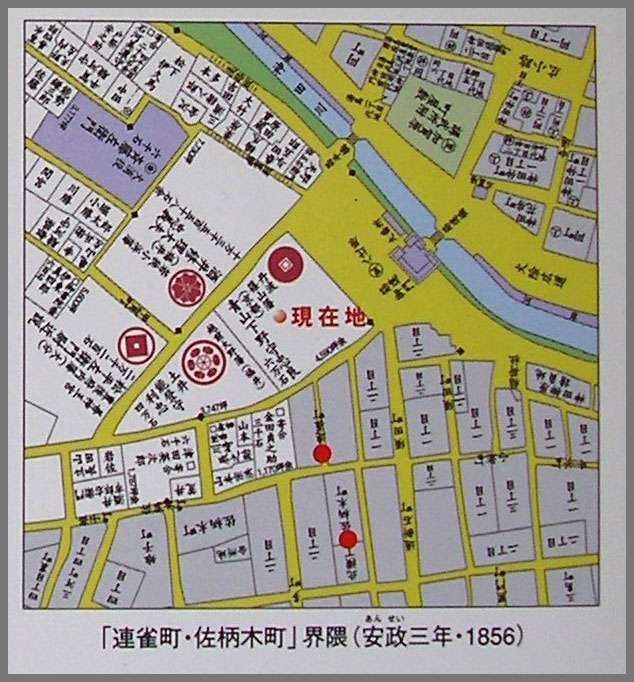[ . BACK to DARUMA MUSEUM TOP . ]
. Onipedia - 鬼ペディア - Oni Demons - ABC-List - .
::::::::::::::::::::::::::::::
oomagatoki, Ōmagatoki 逢魔時 / 大禍時 "demon dusk"
. kure 暮れ dusk, nightfall, twilight .
tasogaredoki たそがれどき, 黄昏
In former times there were no street lights and it was difficult to see the faces of people when you walked at nightfall. Still not yet the time for a lantern to find your way. So when people met, they would exchange a greeting:
Taso kare wa? 誰そ、彼は (dare daroo, are wa?) "Who is this?". Taso kare ... became tasogare in the course of time, now loaded with the feeling of loneliness and melancholy.

- quote -
Ōmagatoki - referring to the moment at dusk when the sky grows dark. Opposite of akatsuki (暁) dawn.
It has specific meanings for the two ways of writing it:
first, 逢魔時 "the time of meeting yōkai, yūrei, and dark creatures"; and
second, 大禍時 "the time of great calamity".
In Illustrated One Hundred Demons from the Present and the Past, Toriyama Sekien described ōmagatoki as the time when chimimōryō, the evil spirits of the mountains and rivers, attempt to materialize in the world.

Chimimōryō, chimi mooryoo 魑魅魍魎 Chimi Moryo
is a term, originated from China dating roughly 2,500 years in ancient chronicles such as the Zuo Zhuan, referring to monsters of the mountains and monsters of the rivers. It refers to various kinds of obake and things changed into yōkai.
"chimi" (魑魅) refers to the monsters of the mountains, and
"mōryō" (魍魎) refers to the monsters of the river,
and so the word "chimimōryō" is often used to refer to all monsters of the mountains and rivers. Furthermore, the word "minori" was also used for this. For this to be used to mean a "ripening" (minoru) oni has been used in various regions since ancient times.
..... a 魑 is a mountain god that took on the shape of a tiger, and
..... a 魅 is a swamp or marsh god taking on a shape with the head of a beast, and it is surmised that from this, what the word was seen to mean expanded to encompass beasts of various attributes.
- - - - - Chimi are said to be monsters that come about from strange atmosphere (miasma) in mountains and forests. Taking on an appearance with the face of a human, and the body of a beast, they would perplex humans. In the dictionary Wamyō Ruijushō from the Heian period, they were considered to be a type of oni under the Japanese name 魑魅 / "sudama", and in the Edo period encyclopedia, the Wakan Sansai Zue, they were seen to be mountain gods (Yama-no-Kami).
- - - - - Mōryō were considered to be spirits from mountains and rivers, and trees and rocks. They would come forth from the life energy of mountains, water, trees, rocks, and all kinds of things in nature, and fool humans. Additionally, they are also said to eat the dead, have the appearance of a child, stand on 2 feet, have dark red skin, have red eyes, long ears, beautiful hair, and a voice that resembles that of a human. With this kind of appearance, they are thought to be oni. In the Wakan Sansai Zue, they are considered water gods (Suijin), and in the ancient Chinese book Zuo Zhuan, they are considered to be gods of swamps and marshes.
- reference source : wikipedia -

魑魅魍魎 - 妖怪巡礼怪奇地図
山口敏太郎 Yamaguchi Bintaro (1966 - )
- 北海道・洞爺湖のトッシーを追う 大沼のサイ伝説 毎夜鳴き声がこだまする〝泣き木〝 岩手・座敷わらし伝説 なまはげ伝承の地 青森・キリストの墓 京都・土蜘蛛の塚 安倍清明神社 一条戻り橋 熊本・河童上陸の地 東京・帝都東京妖怪スポット
..............................
. Yama no Kami 山の神 God of the Mountains .
. Mizu no Kami 水の神 God of the Water .
::::::::::::::::::::::::::::::
- - - - - H A I K U - - - - -
卯の花や逢魔時の通り雨
unohana ya oomagatoki no toori-ame
deutzia blossoms -
a passing rain shower
at demon dusk
Naitoo Toten 内藤吐天 Naito Toten (1900 - 1976)
. u no hana, unohana 卯の花 deutzia blossoms .
- kigo for early summer -
..............................
逢魔時色褪せし薔薇に雨灑ぐ
oomagatoki iro-aseshi bara ni ame sosogu
demon dusk -
rain splatters on the roses
with faded colors
Naitoo Toten 内藤吐天 Naito Toten (1900 - 1976)

::::::::::::::::::::::::::::::
Chimi Mouryou - webcomic by Rasenth

source : cmmr.smackjeeves.com
::::::::::::::::::::::::::::::

. - - - Join the Onipedia friends on facebook ! - - - .
::::::::::::::::::::::::::::::
. Onipedia - 鬼ペディア - Oni Demons - ABC-List - .
. Tengu 天狗と伝説 Tengu legends "Long-nosed Goblin" .
. - yookai, yōkai 妖怪 Yokai monsters - .
. Legends and Tales from Japan 伝説 - Introduction .
. Mingei 民芸 Regional Folk Art from Japan .
::::::::::::::::::::::::::::::
[ . BACK to DARUMA MUSEUM TOP . ]
[ . BACK to WORLDKIGO . TOP . ]
- #omagatoki -
::::::::::::::::::::::::::::::
--
Posted By Gabi Greve to Kappa - The Kappapedia on 7/02/2017 09:51:00 am


















































